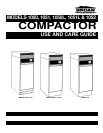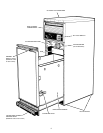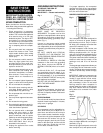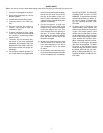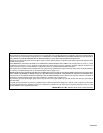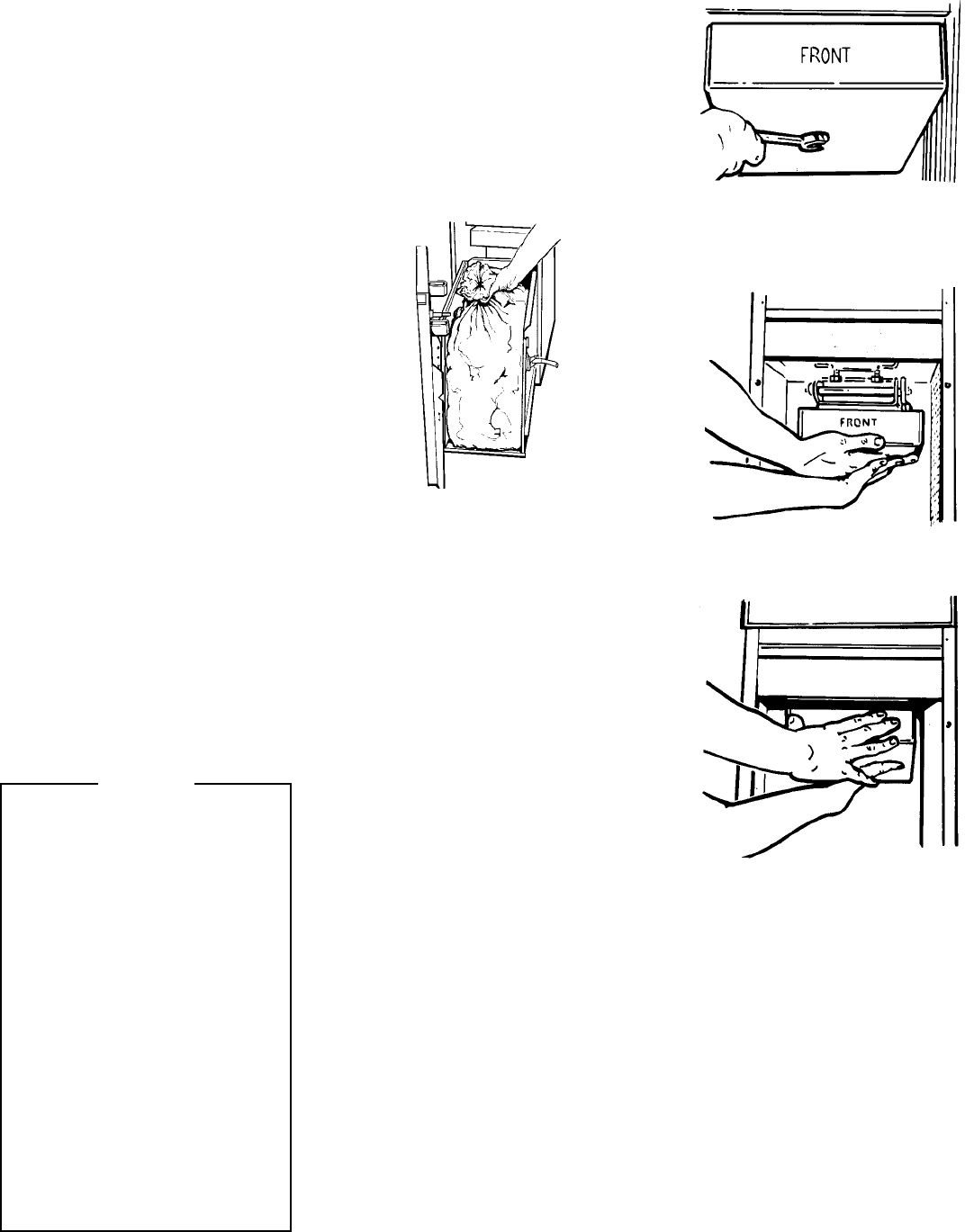
6
TO STOP THE COMPACTOR
The unit may be stopped at any time by
turning the key to “OFF” or opening the
drawer. If the unit is stopped, the ram
will always move back to the up position
when restarted again.
BAG REMOVAL
1. Open drawer to first stop.
2. Unhook container latch from door
catch. Swing door open.
3. Unbutton bag from drawer and close
by twisting bag. Fasten with twist tie
provided.
4. Use a twist-tie to secure the top of
the bag. Pull upward and forward —
tipping the bag toward you. A full
compacted bag of trash is easily re-
moved in this fashion. (Fig. 14)
MAINTENANCE AND CLEANING
Your compactor has been designed with
easy access for cleaning when required.
The interior and exterior of the cabinet
are finished with a durable baked-on
enamel finish.
Do not use harsh or gritty cleanser or
scouring pads which may mar the finish.
Use a high-grade wax cleaner on these
surfaces.
TO REMOVE DRAWER AND CLEAN
INTERIOR
1. Pull out drawer until it stops.
2. Lift up on drawer slightly and then
pull out drawer to second stop.
3. Lift drawer up and out of compac-
tor.
4. Vacuum and clean cabinet base,
track channels, and drawer, particu-
larly in corners.
5. Wash the cabinet interior with nor-
mal mild household cleaners.
WARNING: Glass fragments may be ly-
ing in bottom of cabinet — to avoid in-
jury, use care in cleaning.
RAM CLEANING
1. After removing drawer as described
above, ram can be removed.
2. Remove bolt in center of ram with
1/2” wrench. (Fig. 15)
CAUTION:
WATCH FOR GLASS FRAGMENTS
3. Place hand on ram face, supporting
its entire length. (Fig. 16)
4. With other hand, press back on front
of ram, sliding it until it releases.
(Fig. 17)
5. To replace ram, slide ram into
grooves on mechanism and slide for-
ward until it snaps into position.
6. Replace center bolt with 1/2”
wrench.
Ram should be cleaned with normal, mild
household cleaners.
Although it is not necessary to compact
until the drawer is full or nearly so, it is
suggested that for maximum compac-
tion, you start the compactor each time
a significant amount of trash is added.
At full stroke, the ram does not travel all
the way to the bottom of the container.
Trash in the bottom 1/3 of the container
will be crushed during subsequent com-
pacting.
Glass bottles can make a loud noise
when they break during compaction. This
is normal. Bottles do not always break
during the first cycle. Breaking glass and
associated noise may occur several
cycles later depending on type and vol-
ume of trash.
Bottles and large cans compact best
when laid flat near the center of the
drawer.
Place a couple of folded sheets of news-
paper, or a large grocery bag on top of
the load to be compacted when:
1. Compacting large or several glass
bottles or jars (or any items that
might shatter). This will help prevent
glass fragments and particles from
flying out of drawer into mechanism.
2. Compacting unwrapped messy food
waste. This will help keep the power
ram clean.
There are certain types of trash that cre-
ate exceptionally strong odors such as
raw meat, fish, grapefruit rinds, personal
hygiene items, and disposable diapers.
You may not wish to put such items into
your compactor.
If the compactor will not be used for an
extended period of time, such as during
vacation, remove the bag to prevent a
build-up of undesirable odor.
CAUTION
DO NOT COMPACT AEROSOL CANS
OR ANY OTHER CONTAINERS
STILL HOLDING OR WHICH HELD
TOXIC CHEMICALS, INSECTICIDES,
OR COMBUSTIBLE CONTENTS.
FUMES MAY BE RELEASED THAT
ARE HAZARDOUS TO HEALTH OR
MAY RESULT IN FIRE OR EXPLO-
SION.
NEVER PUSH TRASH INTO THE
CONTAINER WITH HANDS OR FEET.
Trash might contain broken glass,
sharp pieces of metal, etc., which
could cause injury. Never compact
flammable materials in your com-
pactor.
Do not put paint, oily rags, lighter
fluid cans, paint thinner cans, etc.,
in your compactor. Doing so could
result in spontaneous combustion
causing a fire and/or explosion.
Fig. 14
Fig. 15
Fig. 16
Fig. 17



